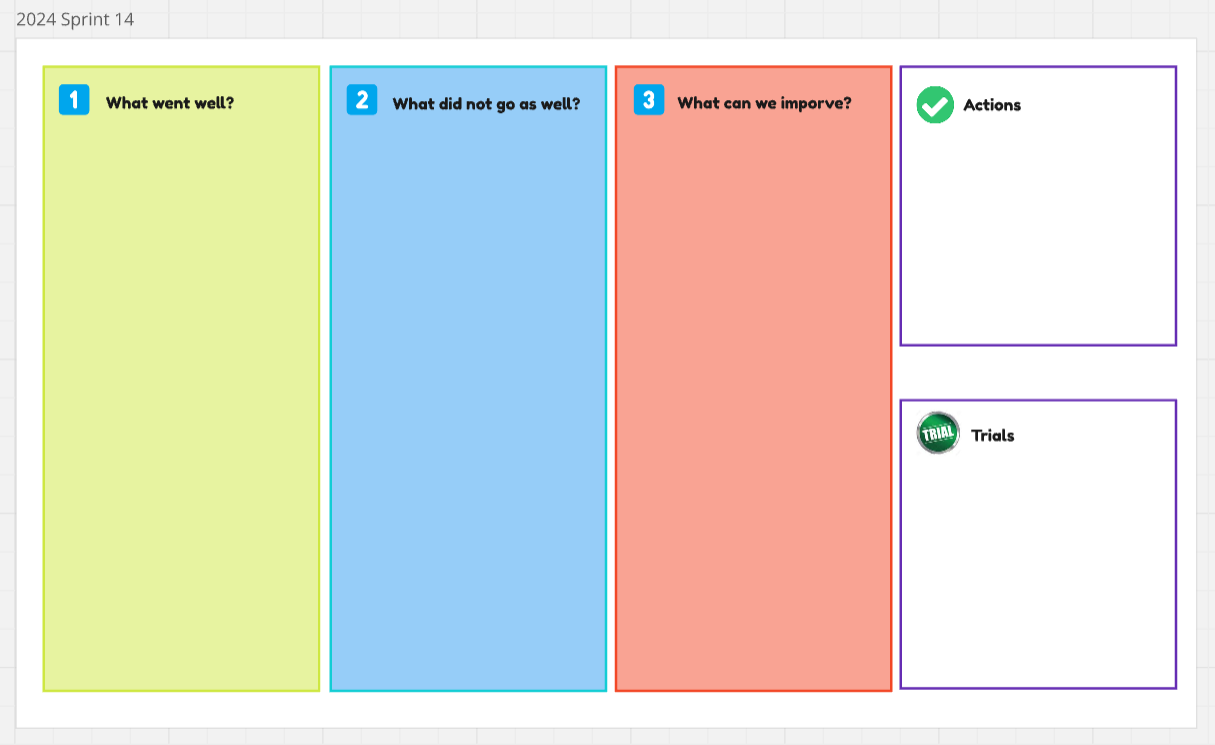Introduction
Every two weeks, after the sprint concludes, the team comes together for a one-hour retrospective meeting in a casual and relaxed atmosphere. The purpose of this gathering is to reflect on the recently completed sprint and offers the team a opportunity for driving continuous improvements and allows every member to celebrate achievements, voice concerns and frustrations, and, most importantly, present new experimental ideas.
The meeting is attended by all team members, and a member of the team takes on the role of facilitating the proceedings. The facilitator can be any team member.
Retro Board
Retro board is divided into three main sections:
- What went well? - what we liked about the sprint, what went well and what we want to build on, shout out to people who helped did exceptionally well
- What did not go as well? - What didn't go so well, or what was missing. If something was unclear or could have been smoother, let's discuss. These are things we definitely want to resolve in the following sprints
- What can we improve? - What's something you wish we were doing that we're not. Will it help us work better and ensure the project is successful. Keep those ideas burning
There is additional two sections dedicated to continuous improvements:
Actions:
They are intended to be completed before the next retro . Each action item requires at least one assignee.
Trials (Experiments):
Trials are dedicated to experiments that the team is currently conducting. The team tries out different approaches or changes. If, after implementing the change for an entire period, the team finds it beneficial, they incorporate it into their regular workflow.
Sample retro board:

During the meeting
The first step is to conduct a review of the previous retrospective. The facilitator will guide the team through a discussion of action items and trial items.
For each action item, we inquire with the team member responsible for the card:
- Has it been completed?
- Should we still proceed with it?
- Is it more complex than initially anticipated?
For each trial item, we ask the entire team:
- Did we carry out the experiment?
- Did we find it effective?
- Should it be part of our ongoing practices?
- Should we carry on with experiment for further evaluation before making a decision?
Next, we allocate 10 minutes for everyone to add cards to the retrospective board. Participants are limited to adding cards only to the main sections, namely What went well? What did not go as well?, and What can we improve? The sections for Action Items and Trial are locked during this time.
Following that, the facilitator guides the team through each card on the retrospective board. Ask the team member who added the card to explain their perspective. Encourage open and honest communication and ensure that everyone has an opportunity to speak. If a card highlights an area for improvement, this is moment when specific cards are created for the Action Items and on Trial items. These represent the most important outcomes of the meeting and are essential elements of continuous improvement. Encourage the team to be creative and consider even seemingly unconventional ideas.
Before closing the meeting, summarise the key points discussed, including the Action Items and on Trial cards. Ensure that everyone has a shared understanding of the outcomes and responsibilities moving forward.
Variations to the meeting
The retrospective meeting can be adapted to address different scopes and objectives. Here are some variations:
- Reflect on a longer timeframe: Instead of focusing on the last sprint, the team can use the retrospective to reflect on the last month or quarter. This allows for a broader perspective and a deeper analysis of patterns and trends over a longer period.
- Project-level discussion: The team can conduct a retrospective that covers an entire project. This form of retrospective allows for a comprehensive review of the project, encompassing a review of various aspects such as the quality of requirements and user stories, identifying reasons for delays, addressing risk management, and handling dependencies, among others.
- Single-topic discussion: Occasionally, the team may find it beneficial to dedicate a retrospective meeting to a specific topic or area of concern. This could be anything from team dynamics and communication to a particular process or tool. By focusing on a single topic, the team can dive deep into the issue and generate targeted actions for improvement.
Remember, the flexibility of the retrospective allows teams to adapt the format to suit their specific needs and circumstances. It’s important to regularly assess and discuss the most relevant areas for reflection and improvement.
Retros are meant to be fun. It’s important to avoid falling into a monotonous routine where we simply go through the motions. For creating variations of activities for retrospective meetings, refer to the website Fun retrospectives.
